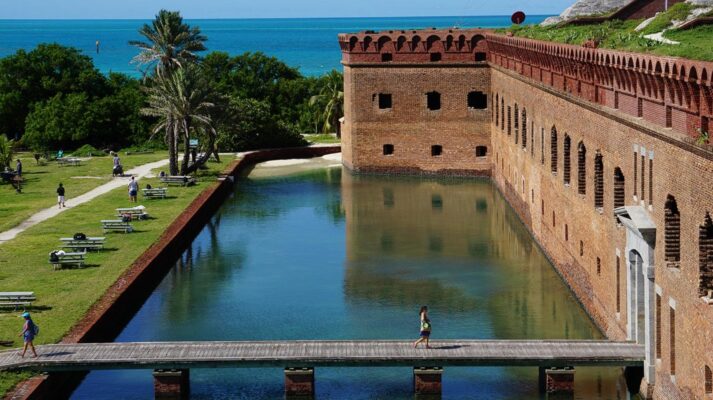Fort Jefferson, an imposing yet unfinished coastal fortress, stands as a testament to the ambitious engineering and strategic planning of 19th-century America. Located on Garden Key in the Dry Tortugas National Park, this massive structure is a fascinating glimpse into the nation’s past and the challenges of building in a remote, island environment.
Architectural Marvel and Historical Context
Fort Jefferson’s sheer size and unique construction make it an architectural marvel, while its historical context sheds light on its intended purpose and eventual abandonment.
Colossal Brick Structure
Fort Jefferson is renowned for its massive scale and the sheer volume of materials used in its construction.

- Largest Brick Masonry:
- The fort is the largest brick masonry structure in the Americas, a testament to the engineering skills and resources of its builders.
- It’s a large brick structure.
- Sixteen Million Bricks:
- Composed of over 16 million bricks, the fort’s construction required a massive logistical effort, highlighting the scale of the undertaking.
- It used a lot of bricks.
- Sixteen-Acre Footprint:
- The fort covers 16 acres (6.5 ha), making it one of the largest forts in the United States, rivaled only by Fort Monroe and Fort Adams.
- It covers a large area.
Dry Tortugas Location
The fort’s remote location in the Dry Tortugas played a crucial role in its strategic importance and eventual abandonment.

- Garden Key Setting:
- Located on Garden Key, the fort’s island setting provided a natural defense and a strategic position for controlling maritime traffic in the Gulf of Mexico.
- It is on an island.
- Sixty-Eight Miles from Key West:
- Situated 68 miles (109 km) west of Key West, the fort’s isolation made it difficult to supply and maintain, contributing to its eventual abandonment.
- It’s far from the mainland.
- Dry Tortugas National Park:
- Today, the fort is part of the Dry Tortugas National Park, preserving its historical significance and natural beauty for future generations.
- It is part of a national park.
Unfinished Legacy
Despite its massive scale and strategic importance, Fort Jefferson was never fully completed, leaving behind a legacy of unfulfilled potential.

- Unfinished Construction:
- The fort’s construction was never completed, due to a combination of factors, including logistical challenges, changing military technology, and the Civil War.
- It was never finished.
- Strategic Purpose:
- The fort was intended to serve as a strategic military outpost, controlling access to the Gulf of Mexico and protecting vital shipping lanes.
- It was meant for military use.
- Changing Military Technology:
- The advent of rifled artillery rendered the fort’s brick walls obsolete, contributing to the decision to abandon its construction.
- Technology changed.
Historical Significance and Modern Preservation
Fort Jefferson’s history is intertwined with the Civil War and its role as a military prison, while its modern preservation efforts ensure its legacy endures.
Civil War and Prison
Fort Jefferson played a significant role during the Civil War, serving as both a military outpost and a prison.

- Union Control:
- During the Civil War, Fort Jefferson remained under Union control, serving as a strategic base for naval operations in the Gulf of Mexico.
- The union controlled the fort.
- Military Prison:
- The fort also served as a military prison, most notably housing Dr. Samuel Mudd, who was convicted of conspiracy in the assassination of President Abraham Lincoln.
- It was also a prison.
- Prison Conditions:
- The harsh conditions and isolation of the fort made it a formidable prison, with inmates facing extreme heat, disease, and isolation.
- Prison conditions were harsh.
Modern Preservation
Today, Fort Jefferson is a national park, attracting visitors and researchers from around the world.
- National Park Status:
- The fort’s designation as part of the Dry Tortugas National Park ensures its preservation and accessibility for future generations.
- It is a national park.
- Tourist Attraction:
- The fort is a popular tourist attraction, drawing visitors interested in history, architecture, and the natural beauty of the Dry Tortugas.
- It is a tourist attraction.
- Research Opportunities:
- The fort provides valuable research opportunities for historians, archaeologists, and environmental scientists, contributing to our understanding of the past and the present.
- It is a research location.
Legacy and Impact
Fort Jefferson’s legacy extends beyond its physical presence, serving as a reminder of the nation’s past and the challenges of building in remote environments.
- Historical Symbolism:
- The fort serves as a symbol of American ambition, engineering prowess, and the challenges of building in remote and challenging environments.
- It is a historical symbol.
- Environmental Significance:
- The Dry Tortugas National Park, including Fort Jefferson, is a vital habitat for marine life, highlighting the importance of conservation and preservation.
- It is environmentally significant.
- Educational Resource:
- The fort provides a valuable educational resource for students and visitors, offering insights into history, architecture, and the natural world.
- It is an educational resource.
Fort Jefferson stands as a testament to the ambition and challenges of 19th-century America. Its massive scale, unique location, and historical significance make it a fascinating and important landmark, offering insights into the nation’s past and the enduring power of human ingenuity.

CÁC TIN KHÁC
Mary Walton: The Forgotten Inventor Who Helped Clean Up America’s Cities
Tomb of Queen Nefertari in the Valley of the Queens, Egypt
Discover the Hypostyle Hall of the Temple of Hathor at Dendera
Venus de Losange: Unveiling the Mystery of a 20,000-Year-Old Paleolithic Icon